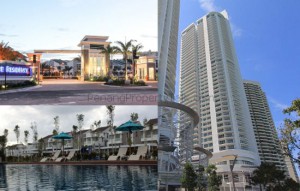Strata management bodies – how do they work?
 As a city grows, the development of high-rises becomes inevitable. So one can only expect more strata developments to be built in Malaysia in the future and strata living will become increasingly common. It is therefore imperative to understand the existence and function of the management bodies that ensure a comfortable and secure strata living environment.
As a city grows, the development of high-rises becomes inevitable. So one can only expect more strata developments to be built in Malaysia in the future and strata living will become increasingly common. It is therefore imperative to understand the existence and function of the management bodies that ensure a comfortable and secure strata living environment.
Beyond the initial management period by the developer upon vacant possession, there are three bodies that a strata owner needs to know: the Joint Management Body (JMB), the Management Corp (MC) and the Subsidiary Management Corp (Sub-MC).
The members of the MC and Sub-MC are made up of solely strata owners while the JMB involves the joint participation of the developer and owners.
Both the JMB and MC have the same function — that is to manage the common properties of a strata development. The JMB is formed within one (1) year from when vacant possession is delivered to the strata owners pending the issuance of strata titles, while the MC is formed upon the issuance of strata titles. In other words, if a strata title is delivered together with the keys to the strata unit, the formation of the JMB is not applicable. If the JMB has been formed and strata titles are then issued thereafter, the JMB will cease to operate when the first AGM of the MC is convened.
The first AGM
According to the Strata Management Act 2013 (SMA 2013), the first AGM of the JMB must be convened no later than 12 months from the delivery of vacant possession. In cases where vacant possession was delivered before the SMA 2013 came into force, the first AGM must be convened within 12 months from the date the SMA 2013 was enforced. Take note that the date of commencement of the SMA 2013 in all states is on May 31, 2016 except for Penang which is on July 11, 2016. Sabah and Sarawak have no strata regime to date, unlike Peninsular Malaysia and Labuan.
On the other hand, the first AGM of the MC will be convened within one month when at least one-quarter of the aggregate share units are transferred from the original landowner to the unit owners.
The strata owners shall become proprietors once their interest in the parcels have been duly registered in their respective strata titles. Strata owners must be aware that they are eligible to vote and to become a member of the MC committee only when they have settled all dues and payable sums to the management body at least seven days before the first AGM.
The function of the management bodies is unquestionably to manage the development especially its maintenance, and to preserve the condition of its common property. Management bodies collect “Service Charges” and “Contributions to Sinking Fund”. They can also make additional by-laws. These are not exactly laws but more like house rules that apply to every parcel owner. They can also list defaulters on the general notice board.
The Sub-MC
Given the rise of mixed-use developments and their unique structure, where they share common infrastructure, the SMA 2013 introduced the Sub-MC to ease the management dilemmas that affect such developments. One common dilemma is whether the funds collected from the residential parcel should be used on the maintenance of the common property at the commercial parcel or vice versa.
The Sub-MC can also be formed for a wholly residential project when there is a need to have a separate management. An example would be penthouse unit owners who are entitled to an exclusive garden and infinity pool at the roof top, which are not accessible by other normal strata owners in the same development. Hence, a Sub-MC can be formed to maintain these exclusive facilities. The SMA 2013 allows a Sub-MC to manage the designated Limited Common Property in the development. A Limited Common Property refers to the common property designated for the exclusive benefit of certain strata owners but not all. The Sub-MC shall manage and maintain the Limited Common Property by separately collecting the “Contribution to Sinking Fund” and “Charges” from the entitled owners.
It is within the power of the MC to form a Sub-MC. However, it is not an easy task as it requires 2/3 of the aggregate share units of parcels of all the strata owners to agree with the proposition. Besides, there is also an issue of cost in engaging professionals in the submission as well as the legal compliances.
As you can see, the management bodies decide a series of matters, from managing funds to the recovery of damaged property. It works for the benefit, comfort and enjoyment of each strata owner. Hence, it is always wise to involve yourself in meetings called by the management bodies to have your say on matters that reflect your well-being in the development. Nonetheless, your presence will also act as a form of check and balance on the management body. Just like a public listed company, your unit would fetch better value if its management is well-run.
Chris Tan is a lawyer, author, speaker and keen observer of real estate locally and abroad. Mainly, he is the founder and now Managing Partner of Chur Associates.
Source: TheEdgeProperty.com.my


Which body is responsible for regulatory enforcement if MC is found to abuse their powers & misuse of funds?
My question is
Without any notification to the owners my previous management set up an MC last year in May. And just last week they update that our maintanance fees will upgrade to double of current fees for the owners of extra car park and extra land in units. Need urgent help.
@Akshera
Which condo?
Does this new act mention anything bout unit owners joint forces taking over the condo management if they find their current management performs unsatisfactory
@Leong See Foon
I think is the commissioner, need to make official complain to them
@Akshera
get all owners there to call EGM..
Guys, google Strata Act 757, download, read & understand it..
Hey Penang Property Agent SinKaKias, ever heard of the ‘Land (Subsidiary Title) Enactment 1972’? If dont have, a free copy is at the link below. Next is a I’ll do ‘mirror translation’ from the LSTE-1972 ‘AGM Original Mix’ to the SMA13 ‘AGM 2013 Remix’, it sounds like this :
“Part V (The Management Corporation), article 14B. – Obligation of original owner to hold FIRST ANNUAL GENERAL MEETING.
K, my argument against your wrongly claim about Sabah do not have a strata law done & I’m done flooding the wall.
Now to stand with your point but getting you stood correctly at the same time is that ‘YES, we do have strata regimes but are they strong regimes? HELL NO! LSTE1972 is WEAK AF! That’s LPPEH has been working hand-in-hand with us East Malaysians to just unified the strata laws, and that’s gonna be known as SMA 2018 applies to all Malaysia! OOpps, I’m not suppose to say this, I think I’ve talked too much and slipped.
https://sagc.sabah.gov.my/sites/default/files/law/Land%28SubsidiaryTitle%29Enactment1972.pdf